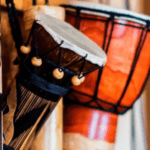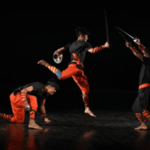Alpana & Kaavi Art: Sacred Expressions of Tradition and Spirituality from Bengal to Coastal India
- indigenousartsfoundation
- September 9, 2024

- Traditional Indian Art Forms That Inspire Spirituality
India’s cultural heritage is rich with traditional art forms that reflect the spiritual and cultural essence of its diverse regions. Two such captivating and timeless folk arts are Alpana from West Bengal and Kaavi Art from the coastal regions of Goa and Karnataka. Both art forms use natural pigments and intricate patterns to invoke blessings and prosperity, making them an integral part of Indian festivals, rituals, and daily life. This blog delves into the beauty, significance, and history behind these sacred folk art traditions.
- Alpana: Sacred Folk Art of West Bengal
Alpana is a traditional folk art from West Bengal, typically created during religious festivals, weddings, and auspicious occasions. This art form involves drawing intricate patterns on floors and walls using a mixture of rice paste and natural pigments. Alpana designs often feature geometric patterns, lotus flowers, conch shells, and fish motifs—each symbolizing purity, prosperity, and protection.
Alpana, traditionally created by women, is more than just decoration—it is a spiritual practice. The act of creating these designs is believed to invite blessings from deities and bring positive energy into the home. With its impermanent nature, Alpana art is typically created for a specific occasion, making each piece a unique reflection of the moment’s sacredness. West Bengal’s Alpana thus remains a beloved tradition, passed down through generations, and continues to transform simple spaces into spiritual canvases.
- Kaavi Art: The Intricate Mural Art of Goa and Karnataka
Kaavi Art is a unique mural art form from the coastal regions of Goa and Karnataka, known for its distinctive terracotta hue and intricate motifs. Created using a reddish-brown pigment made from laterite soil, Kaavi Art is applied to the walls of temples, ancestral homes, and public buildings. This traditional mural art form often features mythological scenes, floral patterns, and geometric designs, symbolizing devotion and prosperity.
With roots dating back centuries, Kaavi Art is a reflection of the coastal region’s rich cultural and spiritual heritage. Skilled artisans meticulously create these murals to adorn sacred spaces, offering a lasting tribute to the divine. The deep connection between Kaavi mural art and spirituality continues to thrive, preserving the cultural identity of Goa and Karnataka while inspiring modern art enthusiasts with its rich history and craftsmanship.
- The Spiritual and Cultural Significance of Alpana and Kaavi Art
Both Alpana and Kaavi Art hold deep spiritual and cultural significance, serving as sacred expressions of tradition. While Alpana is primarily created for festivals and important events in West Bengal, Kaavi Art transforms everyday structures in Goa and Karnataka into sacred works of devotion. These art forms connect people with their cultural heritage and infuse their spaces with positive energy and divine blessings.
Despite their regional differences, both Alpana and Kaavi Art reflect the profound bond between art, spirituality, and the communities that keep these traditions alive. The intricate patterns, natural materials, and cultural relevance of both art forms make them invaluable pieces of India’s spiritual and artistic legacy.
- Preserving India’s Timeless Art Forms
Alpana and Kaavi Art continue to thrive as living traditions, passed down through generations and practiced during festivals, rituals, and special occasions. These traditional art forms serve as reminders of the beauty found in simplicity and the deep connection between art and spirituality. Whether it’s the fleeting designs of Alpana or the intricate murals of Kaavi Art, these folk arts remain timeless symbols of India’s rich cultural heritage. Through their enduring beauty and sacred meanings, Alpana and Kaavi Art will continue to inspire and enrich spaces for generations to come.






